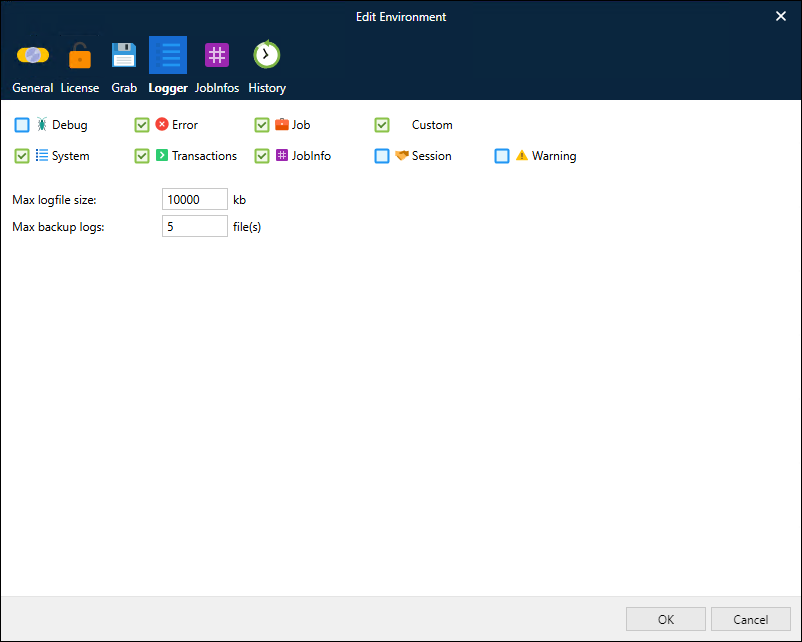- Print
- PDF
Note
For Lasernet server logging information for Lasernet 10, refer to the Lasernet Developer 10 Guide.
Lasernet environments generate logging messages that can help you monitor processing status, monitor the flow of forms through Lasernet, and detect errors.
Access Lasernet Environment Logs
There are two ways to read a Lasernet environment’s log messages:
Lasernet Monitor
Open the environment’s log file
Lasernet Monitor
Lasernet Monitor enables you to view an environment’s live log data. To start Lasernet Monitor, click Lasernet 11 > Lasernet Monitor 11 or Lasernet Developer 11 > Lasernet Monitor 11 in the Windows Start menu.
At the prompt, enter credentials to log in to the selected Lasernet Config Server. Lasernet Monitor will start.
The main part of the window displays log messages. Use the Environment list in the top corner to select which environment to view log messages for.
.png)
For more information about Lasernet Monitor, see Lasernet Monitor Guide.
Log File
In addition to making log messages available in Lasernet Monitor, a Lasernet environment writes log messages to an .lnlog file.
The location of the log file is determined by the environment’s Server runtime data directory location (in Lasernet Service Manager). If this setting is blank, the default location is used: C:\ProgramData\Formpipe Software\Lasernet 11\Service\<environment name> (appropriately substitute <environment name>). Else the location specified by Server runtime data directory is used.
The log file name is Lasernet.<host name>.lnlog (appropriately substitute <host name>). This file contains the newest log messages.
In the Lasernet Config web app, you can configure Max logfile size (in KB) and Max backup logs (as number of files). When the file described above reaches the size specified by Max logfile size, it will be renamed to Lasernet.1.lnlog , and a new blank Lasernet.<host name>.lnlog file will be created. If a Lasernet.1.lnlog file already exists, it will be renamed to Lasernet.2.lnlog , and so on for any other existing log history files. The number of log history files maintained is determined by Max backup logs.
Each Lasernet environment and pod transfers the log messages that it generates to the Config Server. A single combined log file is generated there. The Lasernet Monitor tool fetches this combined log; in that tool, the user can use the Environment list to filter the log messages.
Lasernet Environment Log Content
Lasernet environment logs can contain the following types of messages:
Log Event Type | Description |
|---|---|
Debug | Events that generally produce too much noise to be included in EID_JOB or EID_SYSTEM, but which may provide extra help tracking down a problem or a possible bug in the system. |
Error | Fatal errors that prevent a job from being successfully received, handled, or sent to an output port. |
Job | Log data from the modules as a job passes through them. The Overlay Engine may comment on what overlays are put on or what JobInfo is found. The Forms Engine logs what form was chosen. Information that helps show why the job passes through the system as it does. |
Custom | User-defined log messages. |
System | Boot and shutdown messages. License information about modules. |
Transactions | Log information that shows how a job is received by the input port, handled by the engines, and committed by output ports. Mostly produced by the Job class and the transaction manager. |
JobInfo | Set JobInfo log events. |
Session | This option applies to all modules which communicate with other systems to intercept the session log. Sessions are logged for HTTP, FTP(S), SFTP, POP3, IMAP, File Retriever (FTP(S), SFTP, HTTP), SharePoint, and Web Service. |
Warning | Warnings about unexpected events and errors that occurred but were not fatal errors. |
Specify Which Types of Message Are Included in a Lasernet Environment’s Log
You can specify which types of message are included in the log. To do this, edit the environment’s Logger settings in the Lasernet Config web app:
Sign in to the Lasernet Config web app.
In the Tools menu, click Environments.
Click the environment that you want to configure logging for, then click Edit in the toolbar.
On the Logger tab, clear or select the Debug, Error, Job, Custom, System, Transactions, JobInfo, Session, and Warning checkboxes to choose which type of message to include in the log. The message types are described above.
Warning
Only select Debug or Session for Lasernet environments that are used for development or testing purposes. These logging levels are not suitable for use on production Lasernet environments because they can reduce Lasernet’s processing speed and generate a very large number of message lines in the log file. Session log messages can also use a very large amount of server memory.

Optional: If necessary, you can change the default values for Max logfile size and Max backup logs.
Click OK to save and apply your changes.


